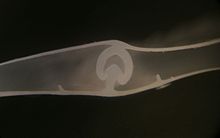Zipper storage bag


A zipper storage bag, slider storage bag, zipper bag, zip lock bag, or zippie is an inexpensive flexible rectangular storage bag, usually transparent, made of polyethylene[1][2] or similar plastic, that can be sealed and opened many times, either by a slider, which works in a similar way to a zip fastener, or by pinching together the two sides of a mechanical sealing mechanism with one's fingers. The bags are made in many sizes; a typical small size is 1.5 by 2.5 inches (3.8 cm × 6.4 cm), and a typical large size is 9 by 12 inches (23 cm × 30 cm). Material thickness (gauge) varies; smaller bags are typically 40 to 45 μm.
Many such bags are used to contain foodstuffs, such as sandwiches and freezer storage. Single and multiple small items for sale are often packed in small zipper bags for convenience and visibility.
Several types of reclosable features are available for plastic bags.[3][4] Sometimes other types of bag, such as a cloth bag for toiletries fitted with a conventional zip fastener, are described as zipper bags.[5]
One bag was patented by Robert W. Vergobbi on May 18, 1954.[citation needed] In the same year, Minigrip licensed them as pencil bags. The zipper storage bag's most recognized function was not realized until 1957, when a fifth-grader named Robert Lejeune demonstrated that the bag could also be used safely as a food storage device.[6] Eleven years later, in 1968, Dow Chemical Company began marketing them under the name Ziploc. Widetrack ribs were added in 1982, clicking zippers in 1993 and color in 1997.[7]
Prior to the 1950s, Ziploc® bags did not exist. In fact, zipper-style reclosable plastic bags had yet to be invented at all. (Ziploc® is the most well known brand of reclosable plastic bags, now owned and registered to S. C. Johnson & Son, Inc.)
The press to close zipper bags we know today evolved from Danish inventor Borge Madsen’s attempt to create a new clothing zipper. Instead of teeth like we see on pants zippers, Madsen’s "separable fastener" design used interlocking plastic tracks and a slider tab. These zippers (pictured in Madsen’s original patent, right) were innovative but impractical for clothing. It was only once Max Ausnit and his son Steven Ausnit purchased Madsen’s patent that the zipper began to get traction as a consumer item.
The Ausnits formed Flexigrip Inc. in 1951 and began to sell the zippers applied to flat vinyl pencil cases and loose leaf binder inserts. While these products were a far cry from the zip lock pouches and other resealable bags we see in grocery stores, they were the early beginnings of these items.
1960s: Press to Close Convenience Arrives
[edit]During the 1960s Flexigrip began to move away from slider-style zippers following Steven Ausnit’s development of a press to close zipper. Not only was this new style more convenient to use, it also reduced material and production costs.
From an Industrial Supply, to a Household Staple
Reclosable zipper bags had gained interest but they were still expensive and complicated to make, mainly due to the fact that the zippers had to be heat sealed to the bags, which added time and cost.
This all changed when Steven Ausnit learned of a Japanese company, Seisan Nippon Sha, that had incorporated a zipper right into the bag. This cut production costs in half. In 1961, Flexigrip negotiated with Seisan to gain exclusive selling rights in the United States and created a new company called Minigrip to market this format.
Minigrip primarily sold to industrial markets until 1964 when they were approached by Dow Chemical for exclusive rights in the supermarket industry. Dow’s polyethylene resin bags were ideal for Minigrip’s reclosable plastic zippers. After several years of negotiation, the Ziploc® bag was introduced to the consumer market.
See also
[edit]References
[edit]- Yam, Kit L (2009). The Wiley Encyclopedia of Packaging Technology. John Wiley & Sons. ISBN 978-0-470-08704-6.
- ^ "Polyethylene (PE) Plastic". UL LLC. January 4, 2016.
- ^ "Ziploc® Brand Freezer Bags". SC Johnson & Son, Inc. Retrieved 4 January 2016.
- ^ US6962439B2, Tahiri, "Leak resistant tamper evident reclosable plastic bag", published 2005
- ^ US3473589A, Gotz, "Plastic bag", published 1967
- ^ "Ten minute zipper bag". Hooray Design Blog. August 1, 2011. Archived from the original on April 26, 2012. Retrieved December 31, 2011.
- ^ "Bag for storage and removal of oxygen",
- ^ Macneal, David (20 April 2015). "The Surprisingly Complex Design of the Ziploc Bag". Wired. Retrieved 20 April 2015.
